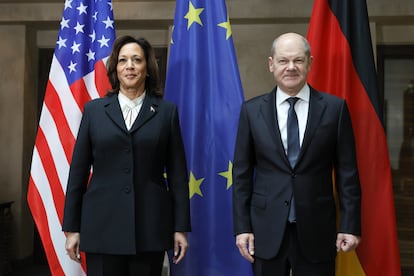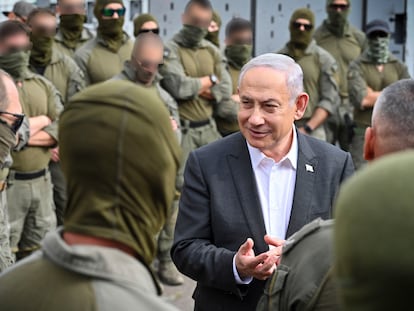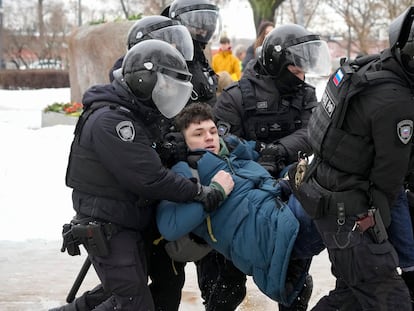An insecure world launches into rearmament with a 9% military spending boom in 2023
Conflicts in Ukraine and Gaza, tensions with China and North Korea, and a possible Donald Trump presidency suggest the current arms race will deepen


An increasingly dangerous world is moving resolutely down the path of rearmament. The Munich Security Conference, held last weekend, clearly portrayed a trend that shows little sign of abating. World military spending in 2023 was 9% higher than in the previous year, reaching a value of $2.2 trillion, a new record in an already upward trend, according to data published by the International Institute for Strategic Studies on the eve of the forum. That figure is roughly equivalent to the GDP of Canada or Italy. Everything points to further growth.
The trend is global and particularly apparent in Europe, due to the Russian war in Ukraine and the prospects of Donald Trump’s return to power in the United States on the back of his comments about Washington’s NATO allies; in the Asia-Pacific region, due to the rise of China and the aggressive rhetoric of North Korea; and the Middle East, in the midst of a turbulent spiral surrounding the hostilities between Hamas and Israel. Rearmament concerns both conventional and nuclear weapons, with the powers embarking on investments to modernize and innovate their arsenals.
At the Munich forum, U.S. Secretary of State Antony Blinken took advantage of the presence of his Chinese and Indian counterparts to share some of the information in his possession about the new nuclear weapon on which, according to Washington, Russia is working. It is a development that would allow Moscow to place an atomic warhead in space, which is forbidden by current international treaties and would allow it to cause massive disruption of all services linked to satellites. Washington is seeking the cooperation of Beijing and New Delhi, which have greater influence over Moscow, to prevent a serious escalation by the Kremlin.
Here is a look at the development of this phase of rearmament in the most strategic regions, in a context in which the United States has by far the largest budget (around $900 billion), followed by China (some $220 billion, almost twice as much if evaluated at purchasing power parity).
Europe
Several European politicians warned at the Munich Conference of the risks linked to Russia’s belligerency and the prospect of an electoral victory for Trump, whose commitment to Ukraine and NATO is doubtful. As of 2014, when the Kremlin annexed Crimea, Europe began to reverse what the head of European diplomacy, Josep Borrell, defined as an era of “silent disarmament.”
The increase in defense spending has accelerated after the full-scale invasion of Ukraine. In 2014, European NATO allies spent $235 billion, 1.47% of GDP. In 2023, that figure rose to $347 billion (both calculated at constant 2015 prices), equivalent to 1.85% of GDP. In 2024, the forecast is for $380 billion and 2%, respectively, according to data published by the Atlantic Alliance.
Olaf Scholz and the President of the European Commission, Ursula von der Leyen, who announced the presentation in three weeks of a new defense industrial strategy and her intention to appoint a Defense Commissioner if she obtains a new mandate in her post. The aim is to increase capabilities both to sustain Ukraine’s resistance in the short term, and to ensure a strong deterrent capability in the face of potential aggression from the Kremlin, particularly if Trump returns to power. “The threat from Russia is real. That is why our deterrence and defense capabilities have to be credible and remain credible,” Scholz said.
Germany, the EU’s leading economy, is fully aligned with that philosophy. Two years ago, just three days after the full-scale invasion of Ukraine by Russian forces, Scholz announced Germany’s biggest political turnaround since reunification, promising that his government would work to move the country toward a consistent military buildup after seven decades of varying degrees of containment marked by the horror of the Nazi experience.
Germany has been increasing its level of military spending since then. Overall, defense spending has hovered at around €60 billion, representing 1.57% of GDP. “I am proud to say that this year we will spend over 2% of our GDP on defense,” said Defense Minister Boris Pistorius, referring to a threshold that is required by NATO. “I am also realistic enough to see that this might not be enough in the years to come,” he added.
Germany’s response comes at a time when the Kremlin has turned Russia into a war economy, where, according to data cited by several sources, a third of the state budget is being used to sustain the war in Ukraine.
Asia-Pacific
In the Asia-Pacific region, the vectors driving spending are multiple. On the one hand, the steady growth of China, which, hand in hand with its long economic boom, promotes the constant improvement and expansion of its military capabilities. These increases, together with plans that have aroused misgivings in the region, have led to greater efforts by other countries in the region, such as Japan and Australia.
On the other hand, the rhetoric and actions of North Korea, which recently removed the traditional goal of a peaceful reunification of the peninsula from its Constitution, represent another factor spurring spending, pushing South Korea, a major global economy, to remain in a high state of alert.
Middle East
The Middle East is also on track for an arms race amid the conflict between Hamas and Israel and the inflammatory effect it has had on a traditionally tense region.
Israel is a nuclear power backed by military support from the United States. Saudi Arabia has for years been carrying out a military build-up that now makes it the sixth-largest spender on defense in the world. Iran does not have the economic muscle to be a significant player in quantitative terms, but it has long been cultivating the development of asymmetric capabilities that will enable it to influence the region.
The conflict between Israel and the United States, on the one hand, and Iran’s partners in the region — triggered in recent weeks by Washington’s bombings in Yemen, Syria, and Iraq — is likely to spur various actors to prepare themselves thoroughly for possible unbridled escalations.
Sign up for our weekly newsletter to get more English-language news coverage from EL PAÍS USA Edition
Tu suscripción se está usando en otro dispositivo
¿Quieres añadir otro usuario a tu suscripción?
Si continúas leyendo en este dispositivo, no se podrá leer en el otro.
FlechaTu suscripción se está usando en otro dispositivo y solo puedes acceder a EL PAÍS desde un dispositivo a la vez.
Si quieres compartir tu cuenta, cambia tu suscripción a la modalidad Premium, así podrás añadir otro usuario. Cada uno accederá con su propia cuenta de email, lo que os permitirá personalizar vuestra experiencia en EL PAÍS.
¿Tienes una suscripción de empresa? Accede aquí para contratar más cuentas.
En el caso de no saber quién está usando tu cuenta, te recomendamos cambiar tu contraseña aquí.
Si decides continuar compartiendo tu cuenta, este mensaje se mostrará en tu dispositivo y en el de la otra persona que está usando tu cuenta de forma indefinida, afectando a tu experiencia de lectura. Puedes consultar aquí los términos y condiciones de la suscripción digital.
More information
Archived In
Últimas noticias
David Bowie, the galactic thinker who encouraged us to break new ground
John Berger and the loss of rural culture
From police officer to bloodthirsty kidnapper: Terror in Mexico during the years of ‘The Ear Chopper’
Alain Aspect, Nobel laureate in physics: ‘Einstein was so smart that he would have had to recognize quantum entanglement’
Most viewed
- David King, chemist: ‘There are scientists studying how to cool the planet; nobody should stop these experiments from happening’
- Reinhard Genzel, Nobel laureate in physics: ‘One-minute videos will never give you the truth’
- Oona Chaplin: ‘I told James Cameron that I was living in a treehouse and starting a permaculture project with a friend’
- Mexico completes its trade shift with the entry into force of tariffs on China and countries without trade agreements
- Sinaloa Cartel war is taking its toll on Los Chapitos










































